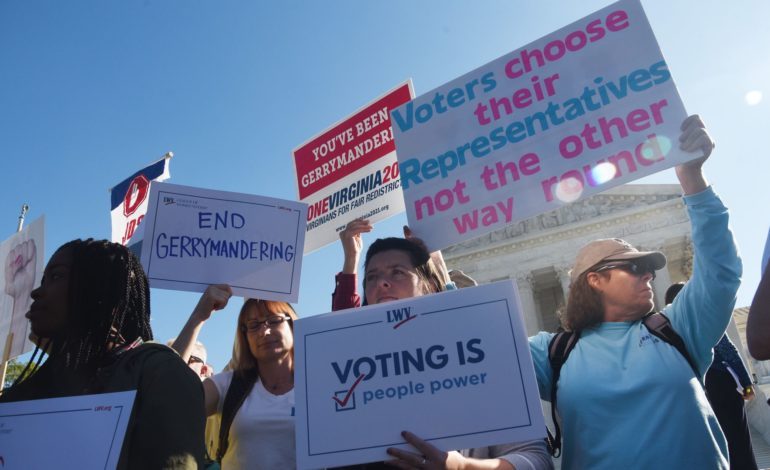

For those curious about how we reached the collapse of American democracy, Slay the Dragon sums up one of the biggest reasons in a single word: gerrymandering. This tactic has always been a part of U.S. politics, dating back to an 1812 political cartoon mocking the lopsided redistricting tactics by Massachusetts governor Elbridge Gerry. But the 2010 midterm elections marked a disturbing shift in its efficiency, with Republicans gaining control of key swing states and redrawing map lines to ensure a drastic upending of the transfer of power. This film breaks down every dirty little detail on how a political party made it so they could never lose power, even with high voter turnout, and the results are chilling.
Slay the Dragon takes gerrymandering’s complicated, overwhelming premise and streamlines it in a manner that any poly-curious citizen can understand. It’s a breakdown of political strategies and shady tactics, with interviews of journalists, lawyers and political figures sprinkled throughout. Intertwining these interviews is the personal story of Michigan activist Katie Fahey, who started the grassroots organization ‘Voters Not Politicians’ to tackle anti-partisan gerrymandering in her state. Her journey began with a simple Facebook post professing interest in the subject and, by the end of the documentary, we see her overcome the odds to put an anti-gerrymandering resolution on the 2018 Midterm ballot. But Fahey’s case is ultimately a microcosm into how 21st century tactics and technology derailed the voter’s power in favor of one side.


In fact, so much of our current political clusterfuckery is a direct result of gerrymandering protecting Republicans from accountability. Even though Obama’s 2008 victory secured Democrats a (temporary) D.C. supermajority, Republicans recognized that the midterms would offer an even greater reward: the ability to control the Census. The result of this evil genius was Chris Jankowski’s RedMap strategy: a $30 million dollar plan, sponsored by a network of right-wing donors ranging from the Koch Brothers to Walmart, to occupy not just the House of Representatives, but state Houses. This allowed Republicans to redraw districts into unreasonably serpentine designs that made absolutely no sense…. unless you wanted to box in the majority of non-white and Democratic voters. Everything else was whitewashed into territories with an obvious right-wing bias.
What followed was a breakdown of what passed previously for bipartisanship. Both moderate Republicans and conservative Democrats were the primary targets, replaced with a number of Meadows, McCarthy’s and Cruz’s who saw the preservation of corporate power as more important than working for the voters. Bills that disproportionately hurt said constituents, ranging from anti-Trans bathroom bills to Scott Walker’s Act 10 anti-union bill, were pushed through despite their unpopularity because the playing field favored a Republicans majority. And when Democrats won more votes in elections to gain said power back, it didn’t matter. The mustache and Donald Duck-shaped districts made sure that higher turnout did not equal more delegates.
This “above accountability” mindset- already exasperated in the Trump era- is evident from the moment Slay the Dragon’s intro brings up the Flint Water Crisis. A problem still without resolution, the crisis was the result of Michigan GOP’s switching the usual Detroit water pipelines with Flint’s lead-based water, a decision made by interest groups from the Tea Party takeover. Yet another scenario in which accountability for a crisis is impossible to make reality. Political power, as the documentary notes, is meant to rise and recede, but the dark money roadblocks orchestrating these tactics keep us locked in a state of hyper-partisanship. If Republicans can’t win votes, they always suppress them in swing states to ensure an electoral victory.


Fahey’s story, by comparison, is meant to reflect the average citizen’s uphill battle to vanquish these dragons. From a simple social media post to a massive grassroots campaign covering all of Michigan’s 83 counties, it’s a sharp contrast to how the RedMap project operated. One worked in secret with data algorithms to suppress minority groups, while the other went into the streets with thousands of volunteers to make their voice heard. People ultimately did something about these unfair political tactics, even when so many obstacles were put in their path.
I’d like to say the film ends on an optimistic note, but even Slay the Dragon acknowledges how daunting things look. With legislatures stacked against democratic rule and the Supreme Court slanted rightward, it’s left to state courts to strike down gerrymandering bias. And one half of America’s political party will do nothing to fix our elections so long as they have the unfair advantage. One only has to look as far back as the 2018 midterm aftermath to see how, rather than concede defeat, legislators chose to strip the incoming governors and assemblymen of power. It can look hopeless at times.
But Slay the Dragon reminds us that, even for those disillusioned with democracy, there’s still sparks of activist light Katie Fahey did it on nothing more than a Facebook post and a desire to see the system work as it should. Democracy works only when people stand up and demand it works, regardless of what those with power do to persuade us otherwise. If the documentary’s activists can make a stand against these unfair systems, what’s our excuse?
Verdict: 4.5 out of 5 Stars
Slay the Dragon is about as helpful as any John Oliver video in breaking down the absurdities and unfairness that encapsulate partisan gerrymandering. That is to say it does its job very well. It presents the issue as something that affects all American communities, regardless of your political stances. And, with the 2020 election underway, the constant timeliness of this narrative is more important than ever. If you’re concerned about democracy, WATCH THIS FILM.
